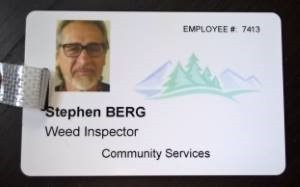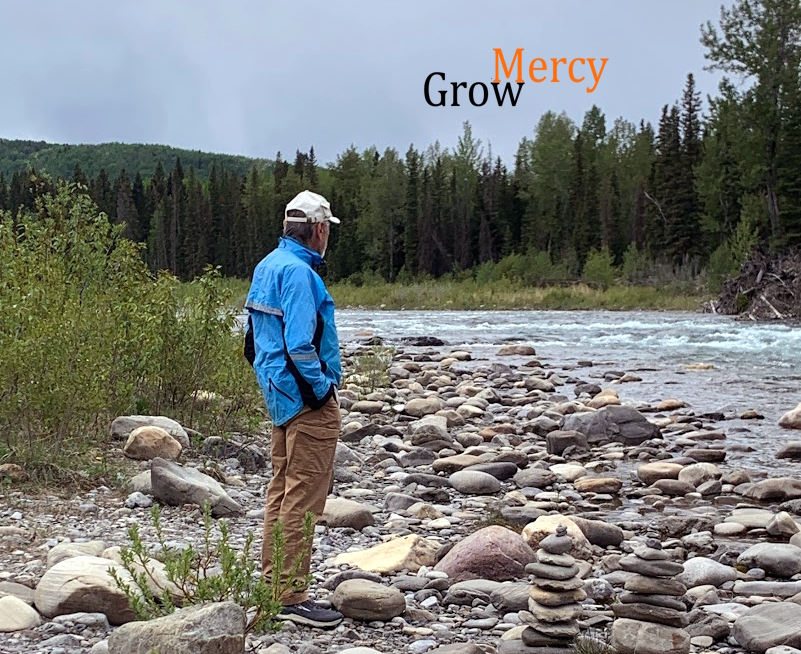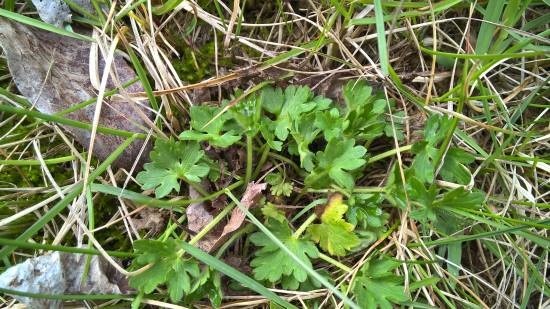When our eonian parents were flung from that divine garden, the first thing they did was scrabble about in the dirt for things to eat. They soon found that not all green and growing things are good for food; and that those things which were good needed protection from botanic creepers, chokers and toxic neighbours. Hence, weed identification—truly the oldest profession—was born.
 I now stand in the ancient tradition of weed identification—a Weed Inspector, in the fecund line of that first unidentified weed inspector, for that first county, somewhere east of Eden. (If there is a weed in need of an identity…I will be there!)
I now stand in the ancient tradition of weed identification—a Weed Inspector, in the fecund line of that first unidentified weed inspector, for that first county, somewhere east of Eden. (If there is a weed in need of an identity…I will be there!)
Of course, here, east of Edson, and now, in the long-tooth neolithic, things are somewhat different. I am governed by the Alberta Weed Control Act and their designations of prohibited noxious and noxious weeds. With the former, the desire is eradication, the later, control.
Although I knew the reality, the cells in me that tend toward the romantic were nevertheless hoping for a more fluid, philosophical approach—eye of the beholder and all that—argue their beauty, their ingenuity, their innocence. As it is, almost all of our “noxious weeds” were imported as ornamentals. A Eurasian invasion was not their own doing. Their fruits were packed into steamer trunks and brought over by hopeful gardeners. You’d think all this would accrue some sort of weedy mercy.
Well, I am fond of weeds. There is no malice in a weed. It does what it does in order to flourish, to bloom—even those wondrous grasses whose micro-blossoms are more energy than actual. And they do this with aplomb. Too much aplomb. Some, much too much.
Having joined the ranks of weed inspection I have begun, although still in training mode, to walk fields and roadways, parks and pastures, scanning—training my eyes to spot and identify, not flowers but cotyledons, first true leaves, seedlings of tall buttercup, orange hawkweed and oxeye daisy…all “noxious weeds.” Here is a seedling of a tall buttercup in a pasture:
I’m learning their mysteries and histories, and yes, toxicities. Consider the spotted knapweed or the garlic mustard plant, both bullies, or rather, allelopathic plants. That is, they secure their own existence by being bastardly toward other plants. There is no symbiosis, no welcome, no getting along, just a built in tendency toward the obnoxious (ob, toward noxa, harm—perhaps there is malice).
So it is for good reason that certain weeds must be asked to permanently relocate or at least to curb their enthusiasm. If not, they would choke out our grain and vegetable crops, poison our livestock, or even, such as the menacing and perfectly named, black henbane, poison us.
My job, simply, is to spy them out, wish them the best but write them up. After that, let’s just say I wash my hands.
WEEDS – Carl Sandburg
FROM the time of the early radishes
To the time of the standing corn
Sleepy Henry Hackerman hoes.
There are laws in the village against weeds.
The law says a weed is wrong and shall be killed.
The weeds say life is a white and lovely thing
And the weeds come on and on in irrepressible regiments.
Sleepy Henry Hackerman hoes; and the village law uttering a ban on weeds is unchangeable law.


Clever, thoughtful, honest, funny, eloquent. As always. Enjoy your summer!
Stephen, As someone who monitors invasive species as part of my work, this is such a wonderful description of the mixed feelings that I have. And the writing is so much more alive than scientific or conservation accounts of those noxious weeds.
Indeed, so many of these things were brought to the continent for a reason. With good intentions. As a plant biochemist, I have to admire the chemical warfare strategies of plants used to ensure their survival and expansion of territory. And as someone who does much work out in the field, I have seen examples of other animals, birds especially, learn to adapt to the new invaders, especially woody-stemmed ones.
Owning an old farm property, I know how it is easy to be a weed inspector, but nearly impossible (at least with my real job and other commitments) to keep them under control. I read about novel ecosystems and think about how many times places have changed in terms of vegetative cover.
But I also think about the fact that humans arbitrarily label things as desirable or not. And the way they go to such lengths to get rid of what they decide that they don’t want around. Be it weeds. Or people. Those undesirables. And wonder where the line between acceptance/tolerance vs. dangerous/eradicate should be.
Elated with what I hope is the first of many rich poetic observations. Thanks and have fun out there!
“old Steve” he has found a bad weed,
his thoughts “I must wipe out the seed ”
It becomes a great fight,
He has dreams in the night ,
In the end he completes the tough deed .
So much fodder for poetry in your future….lovely post, Stephen! And congrats on the very cool job.
Poetic musing that makes even weeds seem worthwhile. I’m glad you can’t help it! I’m wondering whether our medical culture has given enough attention (before we destroy them) to the healing potential of plants we allege to be weeds.
Thank you Connie! Lovely encouragement.
Diane, thanks so much for your response. And so true about our ways of labeling what we wish to dismiss.
Thank you Wenda! And thanks for the wishes.
Phil, thanks for the chuckle…right up there with Sandburg… 🙂
Thank you Shawna. I’m hoping for fodder.
Thanks Ike! Interestingly enough there’s a number of “noxious weeds” that have medicinal qualities.
Hey Steve, when you were young I worried sometimes about whether you’d make anything of yourself…. then you did … but now – Weed Inspector is a real job, eh?
Sam (the elder brother)
Mind you, if you can get paid for something you enjoy doing…. way to go!